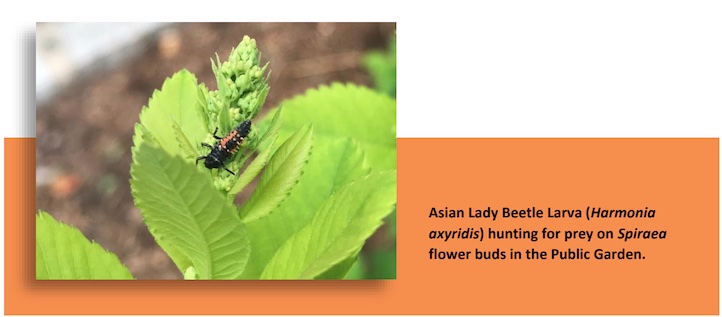
By Christine Helie, Consulting Entomologist, The Growing Tree
Biological Control
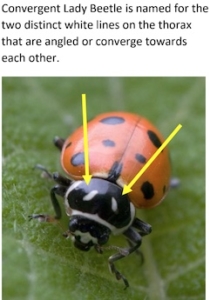 Native insect predators provide the important ecological service of pest control in our gardens and landscapes. In situations where existing populations of a natural enemy are not present or cannot respond quickly enough to the pest population, augmentation, periodically increasing the number of predators, can be effective.
Native insect predators provide the important ecological service of pest control in our gardens and landscapes. In situations where existing populations of a natural enemy are not present or cannot respond quickly enough to the pest population, augmentation, periodically increasing the number of predators, can be effective.
This year we released 200 Convergent Lady Beetles (hippodamia convergen) on Weeping Beeches in the Public Garden and on the Catalpa Tree near the George Robert White memorial fountain where aphid populations are high. Convergent Lady Beetle is native to Massachusetts and both adults and larva are predators of soft-bodied insects with a preference for aphids.
Convergent Lady Beetles (family: coccinellidae) undergo complete metamorphosis and have four distinct stages of development: egg, larva, pupa, and adult. When getting ready to lay eggs, adult females seek out aphid infested trees or plants to ensure that young larvae have a reliable food source. One female can lay between 200 and 500 eggs which hatch in 5 to 7 days. Larvae begin searching for food soon after they emerge from their eggs.
Insect Conservation
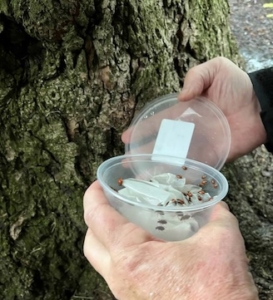 In field research, whenever traps are used to monitor a particular species, there is always a chance that non-target specimens will be caught. Due to their placement and design, the sticky traps, used to capture the European Elm Bark Beetle (scolytus multistriatus) in the three parks, also collect other insects and spiders throughout the monitoring season. While these unintentional captures (referred to as bycatches) are not our main target of study, taking the time to identify these species is a perfect opportunity to increase our knowledge of the spiders and insects that live in our urban parks. Identification is also a necessary first step in distinguishing a beneficial insect from a pest insect. Once an insect or spider has been properly identified we can then learn about their diet, habitat, life cycle, and range.
In field research, whenever traps are used to monitor a particular species, there is always a chance that non-target specimens will be caught. Due to their placement and design, the sticky traps, used to capture the European Elm Bark Beetle (scolytus multistriatus) in the three parks, also collect other insects and spiders throughout the monitoring season. While these unintentional captures (referred to as bycatches) are not our main target of study, taking the time to identify these species is a perfect opportunity to increase our knowledge of the spiders and insects that live in our urban parks. Identification is also a necessary first step in distinguishing a beneficial insect from a pest insect. Once an insect or spider has been properly identified we can then learn about their diet, habitat, life cycle, and range.
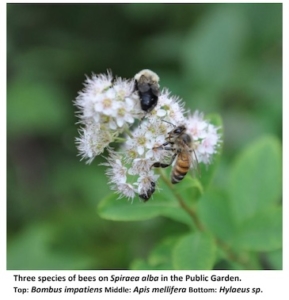 Understanding an insects specific requirements for survival is especially important when we think about the native predators that assist us every day by reducing the number of harmful insects in the parks. For example, almost all the Lady Beetles in North America are predacious as both adult and larva. This includes lady beetle species that reside in the three parks such as the Twice Stabbed Lady Beetle, Spider Mite Destroyer, and Asian Lady Beetle to name a few. These Lady Beetles primarily consume soft bodied insects like aphids or spider mites, but they also supplement their diets with pollen and nectar. Pollen is a source of essential nutrients and protein, while nectar supplies necessary carbohydrates. Unfortunately, both resources are very limited in the urban environment.
Understanding an insects specific requirements for survival is especially important when we think about the native predators that assist us every day by reducing the number of harmful insects in the parks. For example, almost all the Lady Beetles in North America are predacious as both adult and larva. This includes lady beetle species that reside in the three parks such as the Twice Stabbed Lady Beetle, Spider Mite Destroyer, and Asian Lady Beetle to name a few. These Lady Beetles primarily consume soft bodied insects like aphids or spider mites, but they also supplement their diets with pollen and nectar. Pollen is a source of essential nutrients and protein, while nectar supplies necessary carbohydrates. Unfortunately, both resources are very limited in the urban environment.
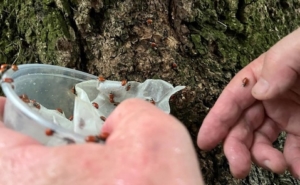 Thankfully, the Boston Common, Public Garden, and Commonwealth Avenue Mall have the potential to fill that void. Through their continued efforts to plant native species and provide care for trees and flowers in the three parks, the Friends of the Public Garden will have a positive impact on the health and survival of the beneficial insects that dwell within the city of Boston.
Thankfully, the Boston Common, Public Garden, and Commonwealth Avenue Mall have the potential to fill that void. Through their continued efforts to plant native species and provide care for trees and flowers in the three parks, the Friends of the Public Garden will have a positive impact on the health and survival of the beneficial insects that dwell within the city of Boston.
Spotlight on Insect and Spider Inventory
 This year, as I continue to gather an inventory of the insects and spiders that live and work in the Boston parks, I identified several Zebra Jumping Spiders (salticus scenicus) on a few of the Elm Bark Beetle Traps. Common throughout the northern hemisphere, Zebra Jumping Spiders do not construct a web but instead actively hunt during the day. They can be found on vertical surfaces such as walls, fences, and tree trunks, stalking prey often much larger than themselves. With their incredibly well-developed eyesight and hunting skills, Zebra Jumping Spiders are important natural predators because they consume a wide variety of plant eating pests found in our landscapes. Zebra Jumping Spiders (salticus scenicus) have vivid black and-white coloration and have excellent vision for pursuing prey.
This year, as I continue to gather an inventory of the insects and spiders that live and work in the Boston parks, I identified several Zebra Jumping Spiders (salticus scenicus) on a few of the Elm Bark Beetle Traps. Common throughout the northern hemisphere, Zebra Jumping Spiders do not construct a web but instead actively hunt during the day. They can be found on vertical surfaces such as walls, fences, and tree trunks, stalking prey often much larger than themselves. With their incredibly well-developed eyesight and hunting skills, Zebra Jumping Spiders are important natural predators because they consume a wide variety of plant eating pests found in our landscapes. Zebra Jumping Spiders (salticus scenicus) have vivid black and-white coloration and have excellent vision for pursuing prey.

